George Fort Gibbs
| George Fort Gibbs | |
|---|---|
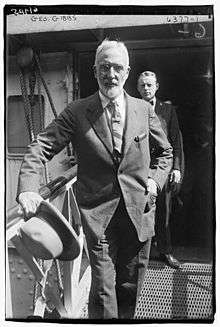 Gibbs circa 1915 | |
| Born |
March 8, 1870 New Orleans, Louisiana |
| Died |
October 10, 1942 (aged 72) Philadelphia, Pennsylvania |
George Fort Gibbs (March 8, 1870 – October 10, 1942) was an American author, illustrator, artist, and screenwriter. As an author, he wrote more than 50 popular books, primarily adventure stories revolving around espionage in exotic locations. Several of his books were made into films. (His novel the Yellow Dove was filmed twice.) His illustrations appeared prominently in such magazines as The Saturday Evening Post, Ladies' Home Journal, Redbook and The Delineator. He also illustrated some of his own novels, and the novels of others. As a painter he produced many portraits, and painted murals for Pennsylvania Station and Girard College in Philadelphia. His screenwriting credits include a film about the life of Voltaire.
Biography
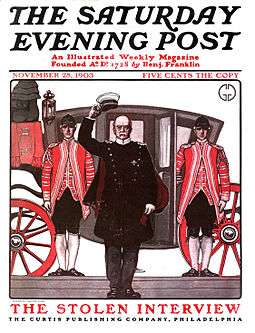
Parents
George Gibbs was born in 1870 in New Orleans.[1] His father, Benjamin F. Gibbs (1836–1882), was a naval surgeon with the ironclad fleet stationed there.[2] Dr. Gibbs had seen much adventure in his naval career. He had taken part in the Paraguay Expedition aboard the USS Memphis. During the American Civil War, he had taken part in the battle of Mobile Bay aboard the steam-sloop USS Ossipee and had been aboard one of the ships that chased the CSS Webb on its dash down the Mississippi.[3]
In mid-war, on February 25, 1864, Dr. Gibbs married Elizabeth Beatrice Kellogg (1837–1883).[4] The bride's father, Major George Kellogg, was a homeopathic doctor brought to occupied New Orleans by General Nathaniel P. Banks, commander of the Army of the Gulf, and assigned to various duties as army surgeon, and as medical advisor to the family of General Banks.[5] Nine months after their marriage, Mrs. Gibbs gave birth to a daughter, Julie Aline Gibbs (1864–1924).[6] In 1870 a son, George Fort Gibbs, was born.
Dr. Gibbs continued to rise in the navy, ultimately attaining the rank of Medical Inspector and being designated Fleet Surgeon of the European Squadron on August 20, 1881.[7] He took Elizabeth, Aline and George with him, settling them in Geneva, where George was enrolled as a student at the Chateau de Lancy for two years.[1][8] Chateau de Lancy also educated such men as William Carlos Williams, Sir Harold Acton and Hamilton Fish.[9] In September 1882, while aboard the USS Lancaster' sailing for Trieste, Dr. Gibbs became seriously ill. According to one source he was probably suffering from "malarial fever".[10] When the ship reached port, he was immediately moved to a hospital, where he died on September 9.[10] His son George was twelve years old at the time.
Elizabeth Gibbs was extremely distraught over her husband's death. The family returned to the United States in November 1883, debarking in New York and then taking a train bound for Washington, D.C., where Elizabeth's father awaited them. George was then thirteen years old, and Aline eighteen. The children were concerned about their mother, who had expressed thoughts of suicide. As the train approached Union Station (at the site of what is now Penn Station) in Baltimore, Elizabeth left her children and entered the ladies' restroom. She was gone for a long time, and the children began to worry. When the train arrived at the station they tried the door of the restroom, but it was locked. George climbed up to a transom and looked in, only to find the room empty, and its window open.[11]
The children notified railroad officials, who sent an engine back down the tracks to look for Elizabeth. Aline went ahead to D.C., to meet with her grandfather, and George stayed behind with the searchers. Later that day Aline received a telegram from George, telling her that their mother had been found lying on the tracks a few miles from the station. Her skull was fractured, and she was taken to a hospital, where she died soon after. She had apparently climbed six feet up to the window and leapt from the train, landing on her head.[11]
Annapolis and Washington, D.C.
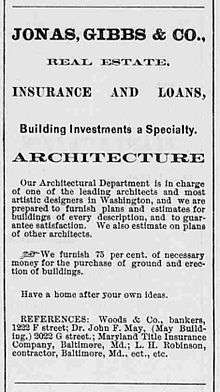
Following in his father's footsteps, George Gibbs entered the U.S. Naval Academy in 1886, but he resigned in 1888.[12] According to critic Grant Overton, Gibbs "generally neglected trigonometry in favor of a sketch book and the writing of verses."[13] While at Annapolis, he contributed drawings, poems and songs to Junk, the Naval Academy yearbook of that era (forerunner of the Lucky Bag, which began publication in 1894 and continues to today), and he edited a collection of material from past editions of Junk after he left the Academy.[1][14] Gibbs also played football at the Academy, "in the gridiron days of skull caps and padless knickers".[15]
After leaving Annapolis, Gibbs returned to Washington and began taking night classes at the Corcoran School of Art and the Art Students' League.[12] He was active in the Washington Watercolor Club and the Society of Washington Artists. By August 1897 he was Treasurer of the Society of Washington Artists, collecting contributions for a fund to open a gallery for the Society.[16] Works by Gibbs and other Washington artists were exhibited in the new gallery at its opening in November of the same year.[17] By 1898, Gibbs was Vice President of the Society.[18]
To support himself during this time, he began writing articles "on science and naval themes" for the Sunday editions of the New York Sun and New York Times.[1][13] (He also tried his hand at writing short stories, but with little success.[13])
By 1891 he was also supporting himself through another enterprise. Together with Frank B. Jonas, Gibbs formed the "Jonas-Gibbs & Co." real estate firm. Frank Jonas was the son of Louisiana Senator Benjamin F. Jonas and cousin of Charles H. Jonas, Jr., who married George Gibbs' sister Aline in 1893. One of the Jonas-Gibbs newspaper ads promised "We are prepared to furnish plans and estimates for buildings of every description, and to guarantee satisfaction."[19] The firm seems to have had an arrangement with "Woods & Co., bankers" to finance new construction. A newspaper account of a Jonas-Gibbs project reports the remodeling of a house on F street, including erecting a "new front of press brick and Ohio stone" and "a large iron vault" in the rear.[20]
By 1896 Gibbs was having some success as a professional illustrator. His first magazine sale had been made sometime shortly after 1892. It was an illustration for the newly created Vogue, and he was paid ten dollars for it.[21] In May 1896, the Washington Morning Times reported that "Mr. George Gibbs is engaged on illustrations for 'navy stories,' by Charles Ledyard Norton, and 'Above the Range,' by Theodora R. Jenness, published by Wilde & Co. of Boston. A series of studies about the Capitol and White House for 'Once a Week' are also on the easel."[22]
In September, the Washington Morning Times reported that Gibbs was setting off for New York with a portfolio of naval illustrations for a publication called The Navy, Old and New,[23] and in May 1897 the Washington Times reported that Gibbs "has just completed a series of seven spirited illustrations for the life of Commodore Bainbridge".[24] The resulting book was Commodore Bainbridge: From the Gunroom to the Quarterdeck, by James Barnes.[25]
Philadelphia
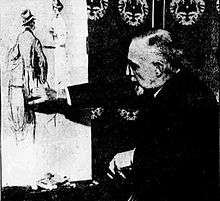
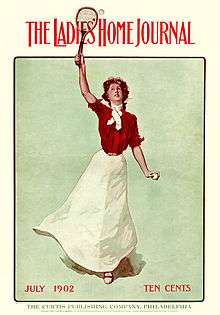
In 1898, Gibbs moved to Philadelphia[12] at the invitation of Cyrus Curtis, founder of the Curtis Publishing Company. There, he created cover and interior illustrations for such Curtis publications as the Saturday Evening Post and the Ladies' Home Journal. Among his early accomplishments was the first color cover for the Saturday Evening Post, which adorned the December 30, 1899 issue of the magazine.[26][27] He also wrote "art critiques and editorials, short stories, etc." for the Saturday Evening Post.[28][29] For a while, Gibbs shared a studio with illustrator Guernsey Moore,[30] the creator of the typeface (called "Post Old Style") used in the Saturday Evening Post logo. Interestingly, an obituary for Moore credits him, rather than Gibbs, as the creator of the first color cover for the Post.[30] Gibbs and fellow illustrator Mills Thompson were among the first to employ the services of model Evelyn Nesbit, who would later become famous after her involvement with architect Stanford White led to his murder by Nesbit's husband.[31]
In April 1901, Gibbs married Maud Stovell Harrison (1878–1973), a classically trained pianist[32] and daughter of a prominent Philadelphia family. The bride's father, Theodore L. Harrison, was the son of Joseph Harrison, Jr., an engineer and railroad magnate who had, in 1843, received a $3,000,000 contract from the Russian government to construct locomotives and rolling stock for the St. Petersburg and Moscow railway.[33] Theodore Harrison had a "wedding cottage"[34] named "The Orchard" built for the couple on the Harrison family property in Rosemont, near Philadelphia. This was to be George Gibbs' home for the remainder of his life.
After his marriage, Gibbs' career as an author blossomed. From 1901 until his death in 1942, he reliably turned out novels at a rate of about one per year.[35] By 1916 newspapers were speaking of Mr. Gibbs' "annual novel".[36] Many of these novels were serialized in newspapers and magazines before being published in book form.[29] His books were primarily adventure novels, in the vein of John Buchan or E. Philips Oppenheim, often involving international intrigue. For example, his novel The Black Stone (1919) is reminiscent of John Buchan's Greenmantle (1916). Both novels involve a sacred stone, and deal with an effort to thwart a German plot to provoke an Arab insurrection.
Gibbs continued to illustrate his own and other authors' books,[35] and to create illustrations for many magazines and newspapers. He also pursued a growing career as a painter.
In time, Gibbs became a pillar of the community and a well-known member of Philadelphia society. When G.K. Chesterton visited Philadelphia in 1921, he stayed at the Gibbs' home.[37] The 1936-37 edition of Who's Who in America notes that Gibbs was a member of the Art Club of Philadelphia, the Franklin Inn Club, the Pegasus Club, the Merion Cricket Club and the Rittenhouse Club.[38] During Chesterton's visit, Gibbs took him to lunch at the Franklin Inn club.[39][40] In 1909, Gibbs discovered a fire in the clubhouse of the Merion Cricket Club, and helped organize a bucket brigade to put it out.[41] Gibbs participated in amateur theatrical productions, in one instance dressing in feathers to play Chanticleer: "We made it a sort of satire on modern letters, with Chantecler chasing Rostand and Ibsen haunted by his characters, and so on. It was very good fun."[15] Gibbs served on juries for many art exhibitions[42][43][44] alongside such luminaries of the time as Frederic Remington and A. B. Frost. The 1925 Haverford College yearbook notes that Gibbs, "the well-known painter and writer of best-sellers", had addressed that school's English Club on the subject of "Writing Novels".[45]
Gibbs was for many years a vestryman of the Episcopal Church of the Good Shepherd in Rosemont. In 1929 he created seven paintings for the church's High Altar reredos as a memorial to his parents. The center panel was a Virgin and Child, flanked by panels depicting other biblical figures from the Old and New Testaments.[46]
By 1915 film makers had begun adapting Gibbs' novels for the screen. The first film based on a Gibbs novel was The Flaming Sword, produced by Rolfe Photoplays, a company that had been founded the previous year by B. A. Rolfe. This was the company's ninth feature film. It starred a young Lionel Barrymore. Between 1915 and 1926 ten films were based on Gibbs novels. In later years, Gibbs collaborated with lawyer E. Lawrence Dudley to write a "novel" about Voltaire at the request of George Arliss, intended to be the basis for a film. After several false starts, the film was finally produced in 1933.
George Gibbs died on October 10, 1942, after a long illness.[1] He was buried on October 14 in Laurel Hill Cemetery in Philadelphia. [47] [48]
Children
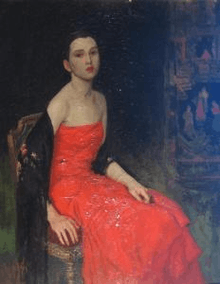
George Fort Gibbs, Jr. (1902–1988) was a member of the Princeton University class of 1923.[49] While there, he participated in college musical groups, serving as leader of the "Banjo Club", for example.[49] The 1930 census lists him as a "play writer" living with his parents in Rosemont,[50] and the Library of Congress Catalog of Copyright Entries lists a 1933 play called "This New Deal" authored by George F. Gibbs, Jr., and M. Mark Sulkes.[51] George Gibbs, Jr., ultimately moved to Venice, Florida, where he became a real estate developer.[52] He continued to be known as an amateur musician, and was one of the founders of what is now called the Sarasota Orchestra.[53]
Theodore Harrison Gibbs (1908–1944) was a well-regarded sculptor. In 1938 he won the prestigious Prix de Rome fellowship [54] and travelled to Rome to work at the American Academy. There, he met and married his wife, sculptor Maurine Montgomery. After the couple moved back to the United States, Harrison enlisted in the military and served in France during World War II. When he left the United States, Maurine was pregnant with their daughter Romona. Harrison was killed in 1944 during the Battle of the Bulge. Maurine and Romona were frequent visitors at "The Orchard". A large stone barn on the property was used as a sculpture studio by Harrison and Maurine. In 2011 the property was finally sold out of the family and many works of art by Harrison, Maurine and other family members were dispersed to museums and other new locations.[55]
Sarah (Sally) Stovell Gibbs McClure (1912–2006) was a dancer, singer, songwriter and author of poems, novels and plays.[32] At the age of nineteen she produced a book of poems called Beauty for Ashes.[56] In 1928, when she was sixteen, she danced in the Philadelphia Grand Opera Company's production of Carmen.[57] By 1934 she was singing and acting on Broadway in Life Begins at 8:40, a musical revue by Harold Arlen, Ira Gershwin and Yip Harburg.[58] She married Navy test pilot Howard McClure in 1941. McClure died in 1960, at which point Sally moved back to "The Orchard" to care for her mother (who lived until 1973), and remained there until her own death in 2006. While at "The Orchard" she taught flamenco and hula dancing. She was the last of her family to occupy the property. Toward the end of her life she wrote and self-published a fictionalized memoir titled Main Line Maverick.[59]
Books
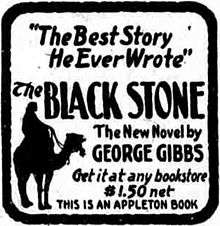

The Library of Congress Online Catalog gives "Gibbs, George, 1870-1942" as the author of the following books:
| Title | Publisher | Year |
|---|---|---|
| Junk: a collection of songs and poems by cadets at the United States naval academy | Washington, D.C., The Patentee publishing company | 1889 |
| Pike & Cutlass; Hero Tales of Our Navy (archive.org) | Philadelphia, London, J.B. Lippincott company | 1900 |
| In Search of Mademoiselle (archive.org) | Philadelphia, H. T. Coates & Co. | 1901 |
| American Sea Fights; Twelve Paintings | New York, R. H. Russell | 1902 |
| The Love of Monsieur (archive.org) | New York, London, Harper & Brothers | 1903 |
| The Medusa Emerald | New York : D. Appleton and Company | 1907 |
| Tony's Wife | New York ; London : D. Appleton and Company | 1910 |
| The Bolted Door (archive.org) | New York and London, D. Appleton and company | 1911 |
| The Forbidden Way (archive.org) | New York and London : D. Appleton and company | 1911 |
| The Maker of Opportunities (archive.org) | New York, D. Appleton | 1912 |
| Madcap (archive.org) | New York ; London : D. Appleton and Company | 1913 |
| The Silent Battle (archive.org) | New York ; London : D. Appleton and Company | 1913 |
| The Flaming Sword (archive.org) | New York and London, D. Appleton and company | 1914 |
| The Yellow Dove (archive.org) | New York and London, D. Appleton and company | 1915 |
| Paradise Garden; the Satirical Narrative of a Great Experiment (archive.org) | New York [etc.] D. Appleton and Company | 1916 |
| The Secret Witness (archive.org) | New York, London, D. Appleton and Company | 1917 |
| The Golden Bough | London, Appleton | 1918 |
| The Black Stone (Google books) | New York ; London : D. Appleton and co. | 1919 |
| The Splendid Outcast (archive.org) | New York, London, D. Appleton and company | 1920 |
| Youth Triumphant (Google books) | New York : D. Appleton | c.1921 |
| The Vagrant Duke (archive.org) | New York, London, D. Appleton and company | 1921 |
| The House of Mohun (archive.org) | New York, London, D. Appleton and Company | 1922 |
| Fires of Ambition | New York, London, D. Appleton and company | 1923 |
| Sackcloth and Scarlet | New York, D. Appleton and Company | 1924 |
| How to Stay Married | New York, London, D. Appleton and company | 1925 |
| Mad Marriage | New York, London, D. Appleton and company | 1925 |
| The Flame of Courage | New York, London, D. Appleton and Company | 1926 |
| The Love of Mademoiselle | New York, London, D. Appleton and Company | 1926 |
| The Up-grade | New York, London, D. Appleton and Company | 1927 |
| The Castle Rock Mystery | New York, London, D. Appleton and Company | 1927 |
| The Joyous Conspirator | New York, J. H. Sears & Company, inc. | c.1927 |
| The Shores of Romance | New York, London, D. Appleton and Company | 1928 |
| The Passionate Prelude | New York, J. H. Sears & company, inc. | c.1929 |
| Isle of Illusion | New York, J. H. Sears & company, inc. | c.1929 |
| The Fire Within | New York, London, D. Appleton and company | 1930 |
| Old Philadelphia | New York, London, D. Appleton and Company | 1931 |
| Foul Weather | New York, London, D. Appleton and company | 1933 |
| Honor Among Women | New York, London : D. Appleton-Century, incorporated | 1933 |
| Out of the Dark | New York ; London : D. Appleton-Century Company, Incorporated | 1934 |
| The Yellow Diamond | New York, London, D. Appleton-Century company, incorporated | 1935 |
| The Vanishing Idol | New York, London, D. Appleton-Century Company, incorporated | 1936 |
| Anything Can Happen | New York ; London : D. Appleton-Century | 1936 |
| Hunted | New York ; London : Appleton-Century Company Incorporated | 1937 |
| The Road to Bagdad | New York ; London : D. Appleton-Century Company Incorporated | 1938 |
| The Silver Death | New York ; London : D. Appleton-Century Company, Incorporated | 1939 |
| The Triangle Man | New York, London, D. Appleton-Century company, incorporated | 1939 |
| The Sleeper Wakes | New York : Appleton-Century | 1941 |
Films
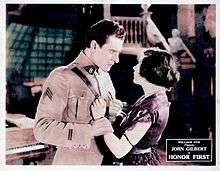
The New York Times obituary for Gibbs says that he "Wrote dialog for more than a dozen motion pictures",[1] but the American Film Institute (AFI) Catalog of Feature Films and the Internet Movie Database (IMDB) only include the eleven films shown in the table below.[60][61]
| Film | Year | Gibbs' Role(s) | Notes |
|---|---|---|---|
| The Flaming Sword | 1915 | author | Based on Gibbs' novel of the same name. The film starred the young Lionel Barrymore. |
| The Madcap | 1916 | author and screenwriter | Although the AFI Catalog doesn't acknowledge this, the Progressive Silent Film List (PSFL) notes that the film is based on Gibbs' 1913 novel of the same name.[62] |
| The Silent Battle | 1916 | author | Based on Gibbs' novel of the same name. Not listed in the AFI Catalog, but appears in the Internet Movie Database.[61] |
| Paradise Garden | 1917 | author | Based on Gibbs' novel of the same name |
| Shadows of Suspicion | 1919 | author | Based on Gibbs' novel The Yellow Dove. This was the last movie in which Harold Lockwood starred. He died of influenza during the 1918 Spanish flu pandemic before the film was finished, and a double was used to complete the film.[63] His leading lady was Virginia Rappe who later figured tragically as the victim in the Fatty Arbuckle rape and manslaughter case. |
| Honor First | 1922 | author | Based on Gibbs' novel The Splendid Outcast |
| The Bolted Door | 1923 | author and screenwriter | Based on Gibbs' novel of the same name |
| Enemies of Children | 1923 | author | Based on Gibbs' novel Youth Triumphant |
| Sackcloth and Scarlet | 1925 | author | Based on Gibbs' novel of the same name |
| The Great Deception | 1926 | author | Based on Gibbs' novel The Yellow Dove. The second film based on this novel, it features Basil Rathbone as a villainous German agent. |
| Voltaire | 1933 | author | Based on a novel by George Gibbs and E. Lawrence Dudley. Dudley took on the task of writing the novel at the instigation of George Arliss, who had an ambition to play the role of Voltaire in a film, and sought a novel as the basis for a screenplay. He had tried to convince other authors (such as George Bernard Shaw) to write it, but without success. Around 1919, Dudley, an acquaintance of Arliss, took on the task and recruited his friend and fellow member of the Franklin Inn Club, George Gibbs, to help him write it. The movie was planned and canceled several times before it was ultimately produced in 1933.[64][65] |
References
- 1 2 3 4 5 6 "George Gibbs Dead; Novelist, Painter", New York Times, October 11, 1942.
- ↑ "Medical Inspector B.F. Gibbs", New York Times, September 10, 1882.
- ↑ New Orleans (La.) Justices of the Peace. Index to Marriage Records, 1846-1880.
- ↑ Cleave's Biographical cyclopaedia of homoeopathic physicians and surgeons, Egbert Cleave. Galaxy Publishing Co., 1873.
- ↑ Aline Gibbs Jonas gravestone at Oak Hill Cemetery, Washington, D.C.
- ↑ "Writers of the Day", The Writer, Vol. XII, No. 1, Boston, January 1899, p. 167.
- ↑ "War Closes a Famous Swiss School", New York Times, June 30, 1918.
- 1 2 "Death of Surgeon Gibbs", The Daily Picayune, New Orleans, Louisiana, September 14, 1882.
- 1 2 "A Leap from a Train. A Deranged Lady's Method of Putting an End to Her Existence", The Sun, Baltimore, Maryland, November 3, 1883.
- 1 2 3 Who's who in Pennsylvania: a biographical dictionary of contemporaries, John W. Leonard (ed.), Second Edition, 1908, L.R. Hamersly & Company, New York.
- 1 2 3 Cargoes for Crusoes, Grant Overton, 1924, D. Appleton and Company, New York.
- ↑ Junk: a collection of songs and poems by cadets at the United States naval academy. Washington, D.C., The Patentee publishing company [1889]
- 1 2 "Illustrates His Own Books", The Sun (New York), February 18, 1911.
- ↑ "Art Gallery in Embryo", The Evening Times (Washington, DC), August 12, 1897.
- ↑ "In Their Beautiful New Home", The Times (Washington, DC), November 21, 1897.
- ↑ "Washington Artists", The Evening Times (Washington, DC), March 26, 1898.
- ↑ Ad in The Sunday herald and Weekly National Intelligencer (Washington, DC), March 22, 1891.
- ↑ Building Notes, The Sunday herald and weekly national intelligencer (Washington, DC), March 22, 1891.
- ↑ The Men Who Make Our Novels, revised edition, by Charles Crittendon Baldwin. New York, Dodd, Mead and company, 1924. p. 199.
- ↑ Art and Artists, The Morning Times (Washington, DC), May 24, 1896.
- ↑ Art and Artists, The Morning Times (Washington, DC), September 27, 1896.
- ↑ Studio Notes, The Times (Washington, DC), May 23, 1897.
- ↑ Commodore Bainbridge: From the Gunroom to the Quarterdeck, by James Barnes. D. Appleton and Company, 1897.
- ↑ American printer and lithographer, Volume 80. Moore Publishing Co., 1925.
- ↑ Covers of the Saturday Evening Post, by Jan Cohn and Joseph Rutt. Viking, 1995. p. xi.
- ↑ Who's Who in America: 1901-1902, edited by John W. Leonard. A.N. Marquis & Company, 1901.
- 1 2 "Stories, listed by Author: GIBBS, GEORGE F(ort) (1870-1942)". The FictionMags Index. The FictionMags Index. Retrieved 1 November 2011.
- 1 2 "T. Guernsey Moore, Noted Artist, Dies; Succumbs at His Home in Swarthmore to Dilatation of Heart; Famed as Decorator", uncredited obituary provided to AskArt.com by Nancy Underwood, great-granddaughter of Guernsey Moore.
- ↑ Prodigal Days: The Untold Story of Evelyn Nesbit, by Evelyn Nesbit. Lulu.com, 2005. p. 11.
- 1 2 S. McClure,94, dancer and author, Philadelphia Inquirer, April 11, 2006.
- ↑ America's Successful Men of Affairs: The United States at Large. Vol. II, edited by Henry Hall. The New York Tribune, 1896.
- ↑ Real Estate ad for 1430 County Line Road Rosemont, PA 19010, Prudential Fox & Roach Realtors-Rosemont, listing number 5808861.
- 1 2 "LOC catalog search for "Gibbs, George, 1870-1942" in books". Library of Congress Online Catalog. Library of Congress. Retrieved 1 November 2011.
- ↑ "Books of the Day". The Philadelphia Inquirer. Philadelphia, Pennsylvania. 1916-10-17.
- ↑ Evening Public Ledger (Philadelphia, PA), January 29, 1921.
- ↑ Marquis, Albert Nelson (1936). Who's Who in America: Vol. 19, 1936-1937, Two Years. Chicago: The A.N. Marquis Company. p. 974.
- ↑ "The Franklin Inn Club: History". The Franklin Inn Club. Retrieved 5 November 2011.
- ↑ "News of Associations and Clubs". Editor and Publisher. Feb 5, 1921. p. 30.
- ↑ "Club Members Save Building from Fire". The Philadelphia Inquirer. Philadelphia, Pennsylvania. 1909-10-18.
- ↑ "The Fine Arts". Boston Evening Transcript. Sep 27, 1906.
- ↑ John Lane Co. (September 1, 1905). "Current Art Events". The International Studio. XXVI, No. 103. New York.
- ↑ "The Fine Arts". Boston Evening Transcript. January 28, 1907.
- ↑ The Record. Haverford College. 1925. p. 140.
- ↑ Ancestry.com. An historical sketch of the Church of the Good Shepherd, Rosemont, Pennsylvania, 1869-1934 [database on-line]. Provo, UT: The Generations Network, Inc., 2005. Original data: Coates, Edward Osborne,. An historical sketch of the Church of the Good Shepherd, Rosemont, Pennsylvania, 1869-1934. Philadelphia: unknown, 1935.
- ↑ Bowlby family genealogy references, "Letter from Fidelity-Philadelphia Trust Company to Kenneth Durant concerning the Joseph Harrison Burial Lot Fund. 16 Nov 1956".
- ↑ Bowlby family genealogy references, "Laurel Hill Cemetery Inscriptions. pg 217".
- 1 2 Princeton Alumni Weekly, May 31, 1922, p. 747.
- ↑ 1930 U.S. Census, Pennsylvania, Delaware County, Radnor Township, District 116, Sheet 3a.
- ↑ Catalog of Copyright Entries, Part 1, Group 3, 1933, Volume 6, No. 1. Library of Congress, Copyright Office, United States. Dept. of the Treasury. p. 57.
- ↑ "Resort Center Lease Revealed", St. Petersburg Times, Feb 15, 1968, p. 19.
- ↑ Sarasota Orchestra History, http://www.sarasotaorchestra.org/history.cfm, retrieved Nov 11, 2011.
- ↑ List of Fellows of the American Academy in Rome 1896–1970.
- ↑ "Ramona Gibbs to take part in symposium at Bradley", Philadelphia Journal Star, October 16, 2011.
- ↑ Beauty for Ashes by Sally Gibbs, Illustrations by Staats Cotsworth. Philadelphia, Dorrance and Company, 1931.
- ↑ Opera in Philadelphia Performance Chronology 1925 - 1949, compiled by Frank Hamilton.
- ↑ The Internet Broadway Database (IBDB) entry for Sally Gibbs, retrieved Nov 5, 2011.
- ↑ Main Line Maverick by Sally Gibbs. iUniverse, 2001.
- ↑ Search AFI Catalog of Feature Films for George Gibbs.
- 1 2 IMDB entry for "The Silent Battle".
- ↑ Progressive Silent Film List entry for The Madcap
- ↑ AFI Catalog of Feature Films entry for Shadows of Suspicion.
- ↑ George Arliss: The Man Who Played God, Robert M. Fells. Scarecrow Press, Oxford, 2004, p. 109.
- ↑ "Edward Lawrence Dudley", Harvard College, Class of 1900, Secretary's Fifth Report, October 1921. Plimpton Press, Norwood Massachusetts. p. 144.